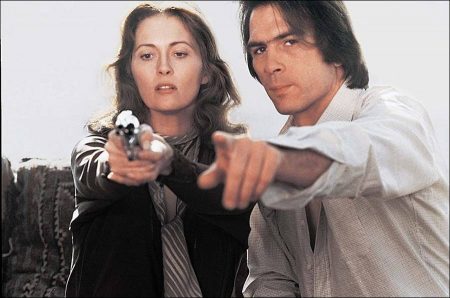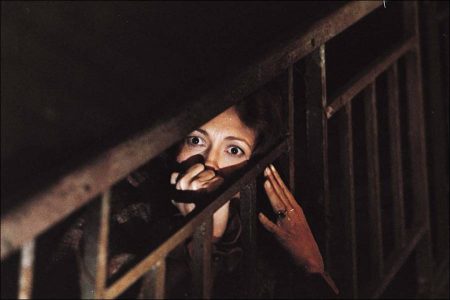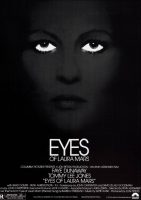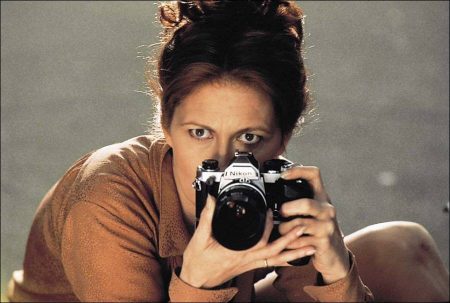
Eyes of Laura Mars movie storyline. New York photographer Laura Mars’ latest exhibit, its associated book titled “Eyes of Mars”, and her continuing current work are considered controversial for the depiction of female sexuality side by side with violence. Laura has been having the occasional vision for several years, which started this thematic work. These visions started as fleeting thoughts, which have now become full blown moving pictures, as if she were looking through a camera lens.
These visions begin to haunt her as she can see people she knows in these visions, they who end up being murdered by a knife through the eyes, the actual murder which she “sees” as it is happening through the eyes of the killer. As the police investigate these murders, she tries to explain to them her visions. The only one of the investigating detectives who believes her is the lead, Lieutenant John Neville. Laura is scared not only for her friends and associates, but also herself as she can see in her visions that the killer is also after her.
As she begins a personal relationship with Neville, she comes to the conclusion that the killer may not be some random nut who solely dislikes her work, but someone that she knows and trusts, the leading candidates being her estranged ex-husband, Michael Reisler, who recently reentered her life, and her driver, Tommy Ludlow, who routinely carries a knife and whose criminal past she had only recently learned.
Eyes of Laura Mars is a 1978 American neo noir mystery-thriller film starring Faye Dunaway and Tommy Lee Jones and directed by Irvin Kershner. The screenplay was adapted (in collaboration with David Zelag Goodman) from a spec script titled Eyes, written by John Carpenter; it was Carpenter’s first major studio film. H. B. Gilmour later wrote a novelization.
Producer Jon Peters, who was dating Barbra Streisand at the time, bought the screenplay as a starring vehicle for her, but Streisand eventually decided not to take the role because of “the kinky nature of the story”, as Peters later explained. As a result, the role went to Dunaway, who had just won an Oscar for her performance in Network.
Streisand nevertheless felt that “Prisoner”, the torch song from the film, would be a good power ballad vehicle for her. She sang it on the soundtrack and garnered a moderate hit as a result (the record peaked at number 21 on the Billboard Hot 100). Eyes of Laura Mars is said to be an example of an American version of the Italian giallo genre. The film is also noted for its use of red herrings and its twist ending.
Film Review for Eyes of Laura Mars
The eyes of Laura Mars see murders. Worse still, they see them through the eyes of the murderer so that glamorous Laura Mars is likely, at any moment, to suddenly “see” the faces of terrified victims about to be stabbed with ice picks.
Moviegoers found that out before the movie opened, in the TV commercials and preview trailers. So what would their minimum expectations be for the film? Maybe they’d (a) want to find out who the murderer is, (b) discover if Laura Mars herself was going to be one of the victims, and (c) learn the secret of who and why Laura Mars has these bizarre visions. Anything less, and we’d feel disappointed, right?
I felt disappointed. I was disappointed because (a) I was able to figure out who the murderer was almost at once, and (c) the movie never explains Laura’s telepathic visions. I was not disappointed, however, in the matter of (b), but then I didn’t expect to be. There’s this whole new genre of movie that Hollywood calls “Women in Trouble.” You see them mostly on TV: A woman is chased by a hostile semitrailer truck, or haunted by the ghost of her late lover, or kidnapped by terrorists. Laura Mars is nothing if she is not a woman in trouble.
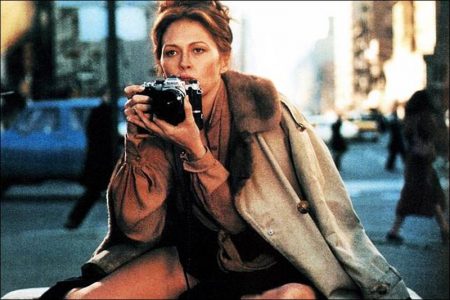
Faye Dunaway, as Laura Mars, is not a great screamer, but she’s a very good one. She’s also well-cast as a controversial fashion photographer, who likes to shoot beautiful women against a backdrop of flaming auto crashes. The women, dressed in spike heels, black mesh stockings and red underwear, attack each other with their fingernails and pull each other’s hair. They also wear expensive fur coats. Photos like this, it’s said, sell coats like crazy. I shouldn’t be surprised. Some people will do anything for a sable.
Anyway, Laura Mars eventually finds that she can no longer function; she has so many visions that she never knows what dread specter will haunt her next. Worse, the visions all come true. Worse than that, the murder victims are all her best friends. If it weren’t for her loyal assistant (Rene Auberjonois) and the understanding policeman (Tommy Lee Jones), she couldn’t carry on. And when the assistant gets killed there is, of course, no end to the suspects. There’s Laura’s insanely jealous, drunken husband, for example. And the shifty-eyed ex-con who’s her chauffeur. But never mind. The movie sets up its suspects so obviously, and they’re so obviously the wrong suspects, that the plot becomes a waiting game. Great, except that we’re the ones who are waiting.
“Eyes of Laura Mars” tries to say Serious Things about fashion photography, corruption in advertising, and the violence in our society. It does not succeed, but it tries. We would not, however, hold its Serious Things against it, if the movie also succeeded as a thriller. It doesn’t, unless your idea of being thrilled is having people leap out of the shadows and then turn out to be friends.
Eyes of Laura Mars (1978)
Directed by: Irvin Kershner
Starring: Faye Dunaway, Tommy Lee Jones, Brad Dourif, Raúl Juliá, René Auberjonois, Lisa Taylor, Darlanne Fluegel, Rose Gregorio, Steve Marachuk, Bill Boggs, Meg Mundy, Marilyn Meyers
Screenplay by: John Carpenter, David Zelag Goodman
Production Design by: Gene Callahan
Cinematography by: Victor J. Kemper
Film Editing by: Michael Kahn
Costume Design by: Theoni V. Aldredge
Set Decoration by: John Godfrey
Art Direction by: Robert Gundlach
Music by: Artie Kane
MPAA Rating: None.
Distributed by: Columbia Pictures
Release Date: August 2, 1978
Views: 193
